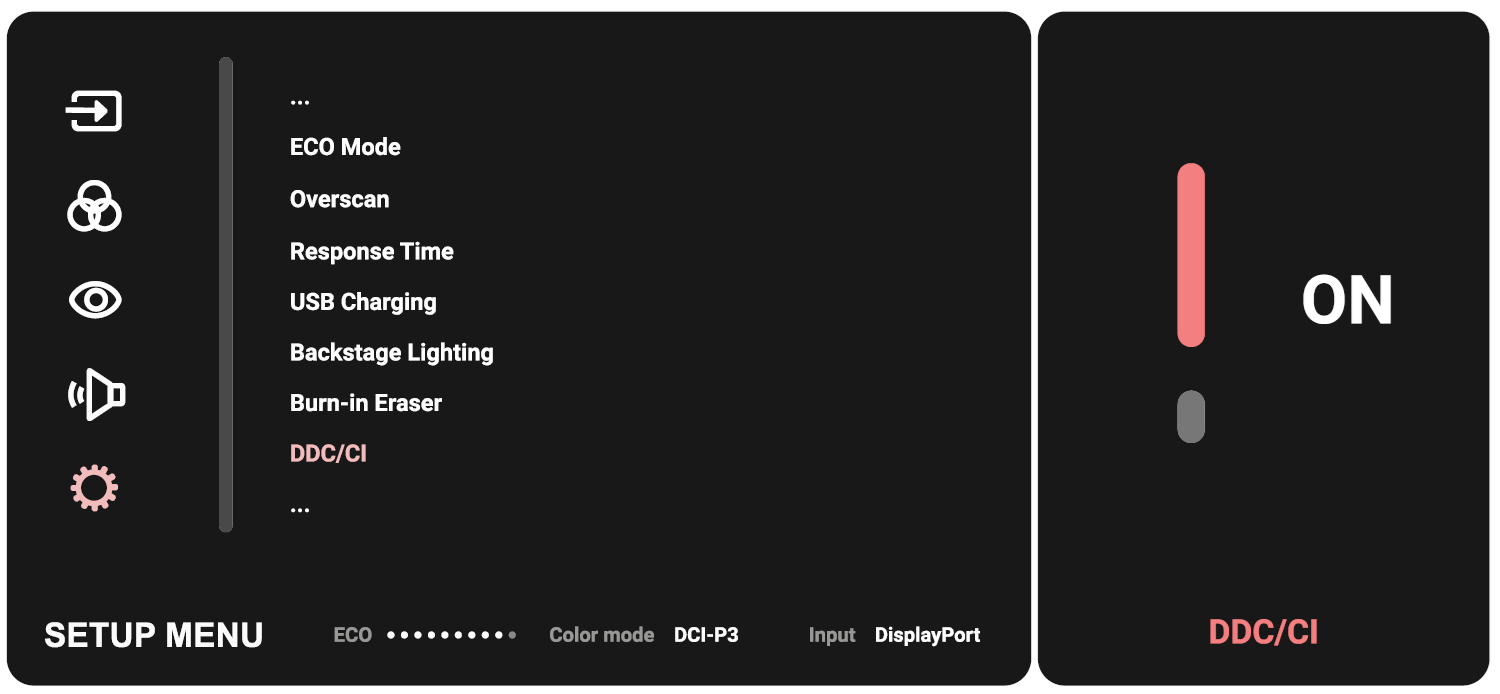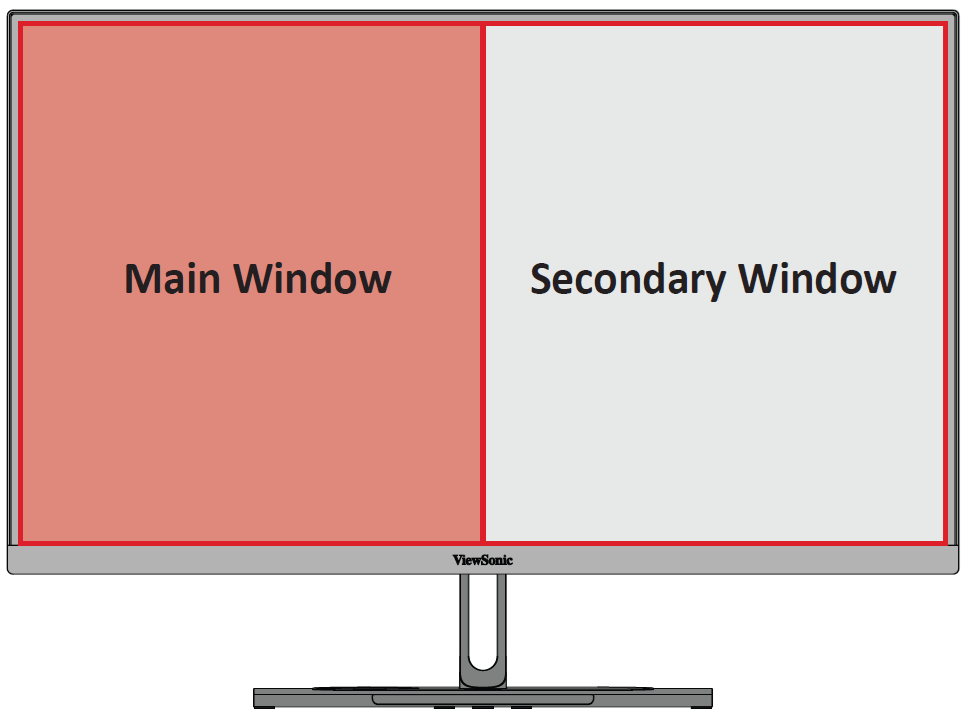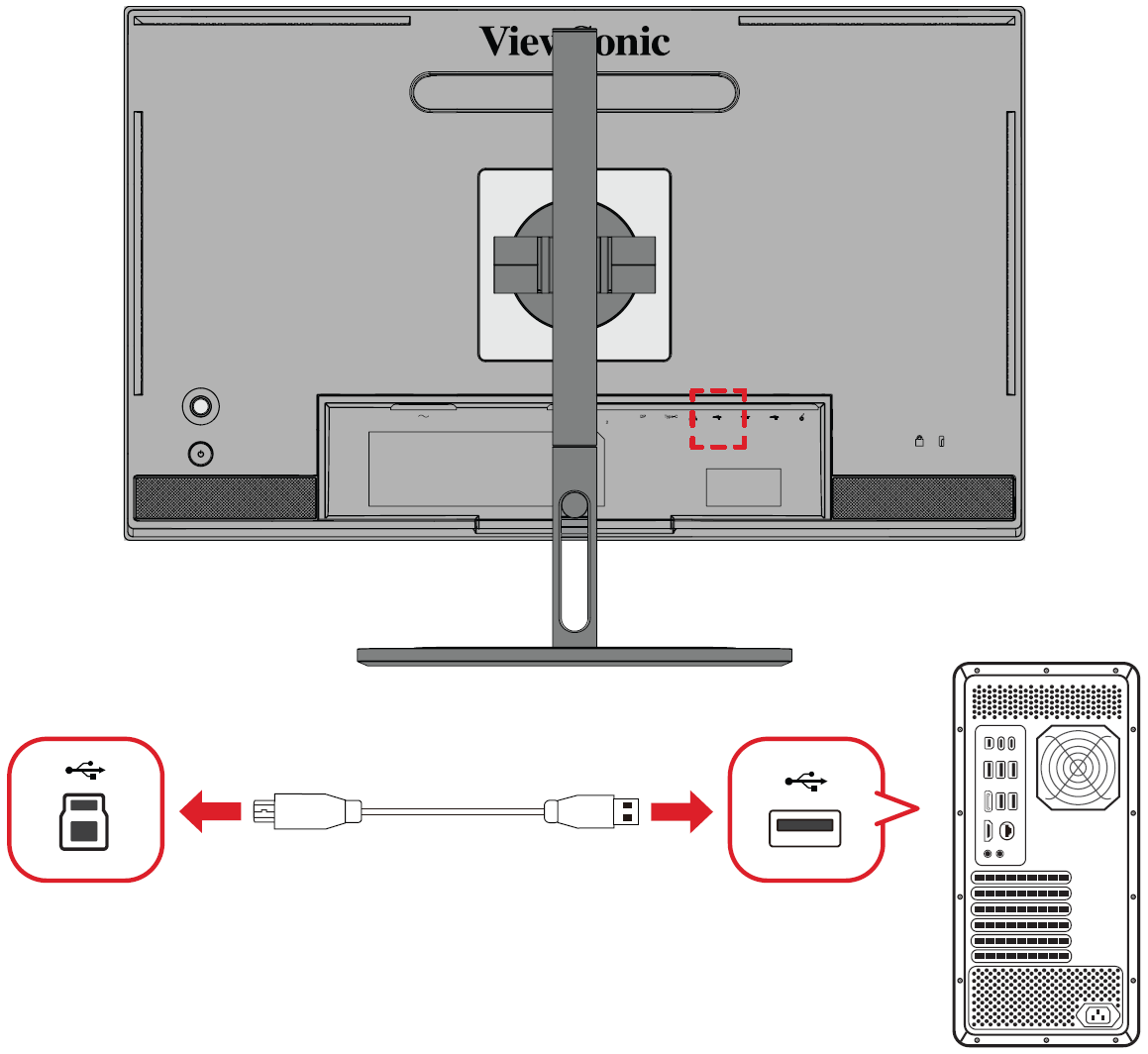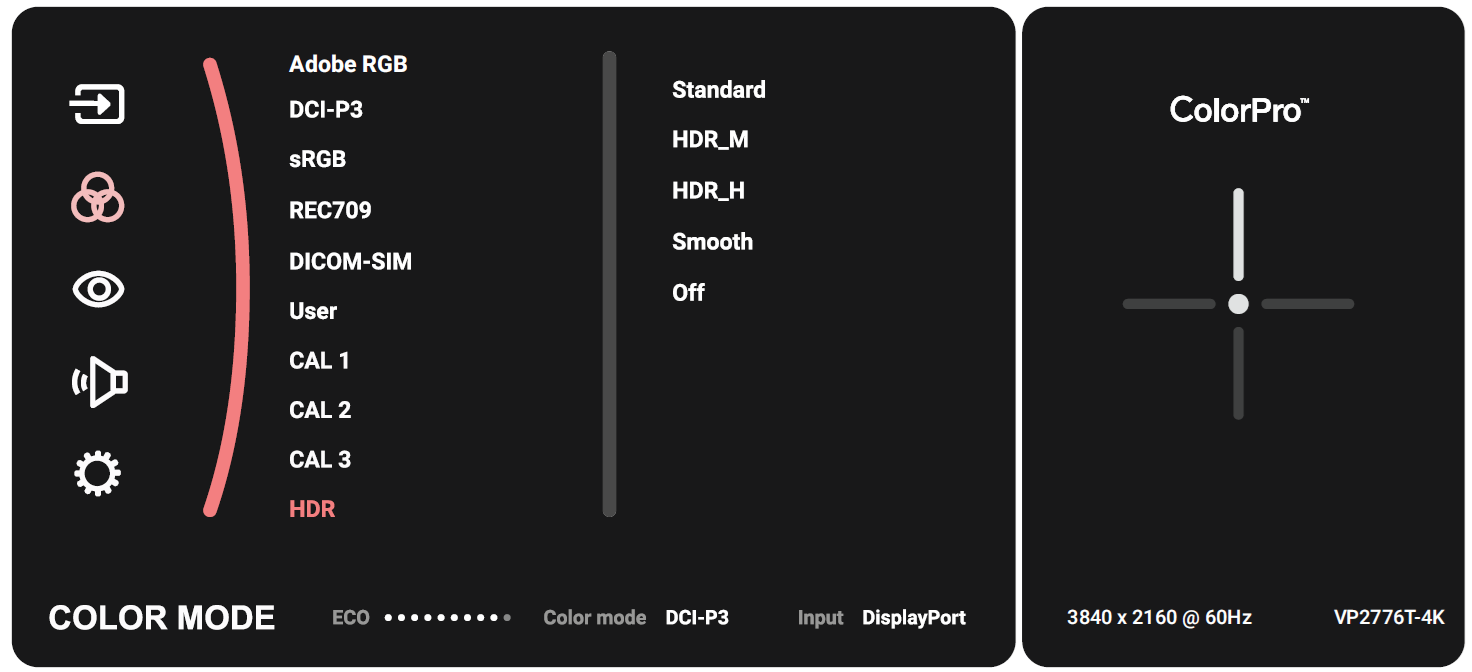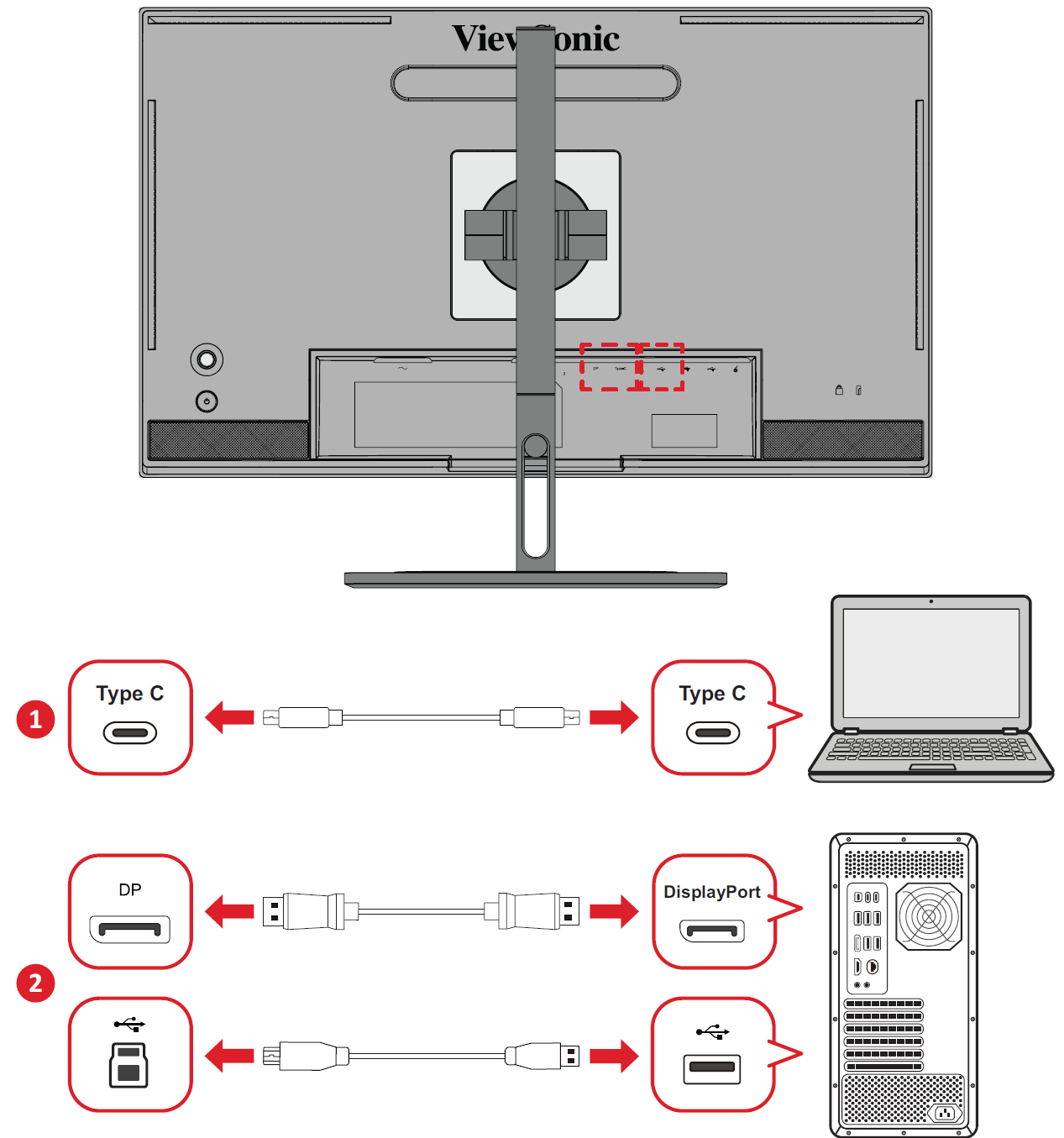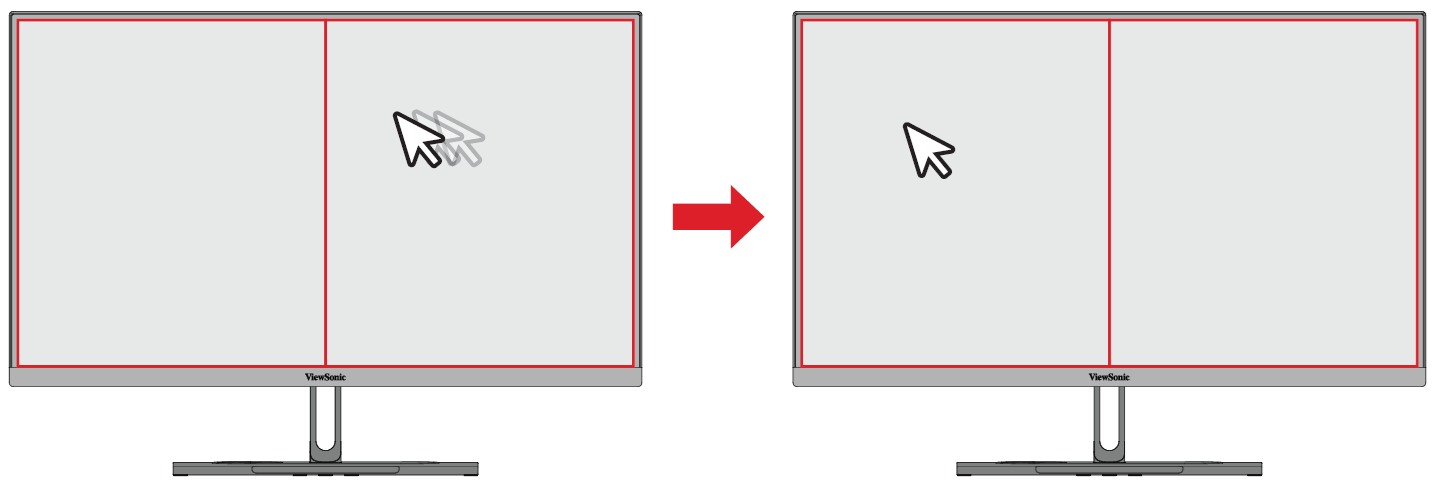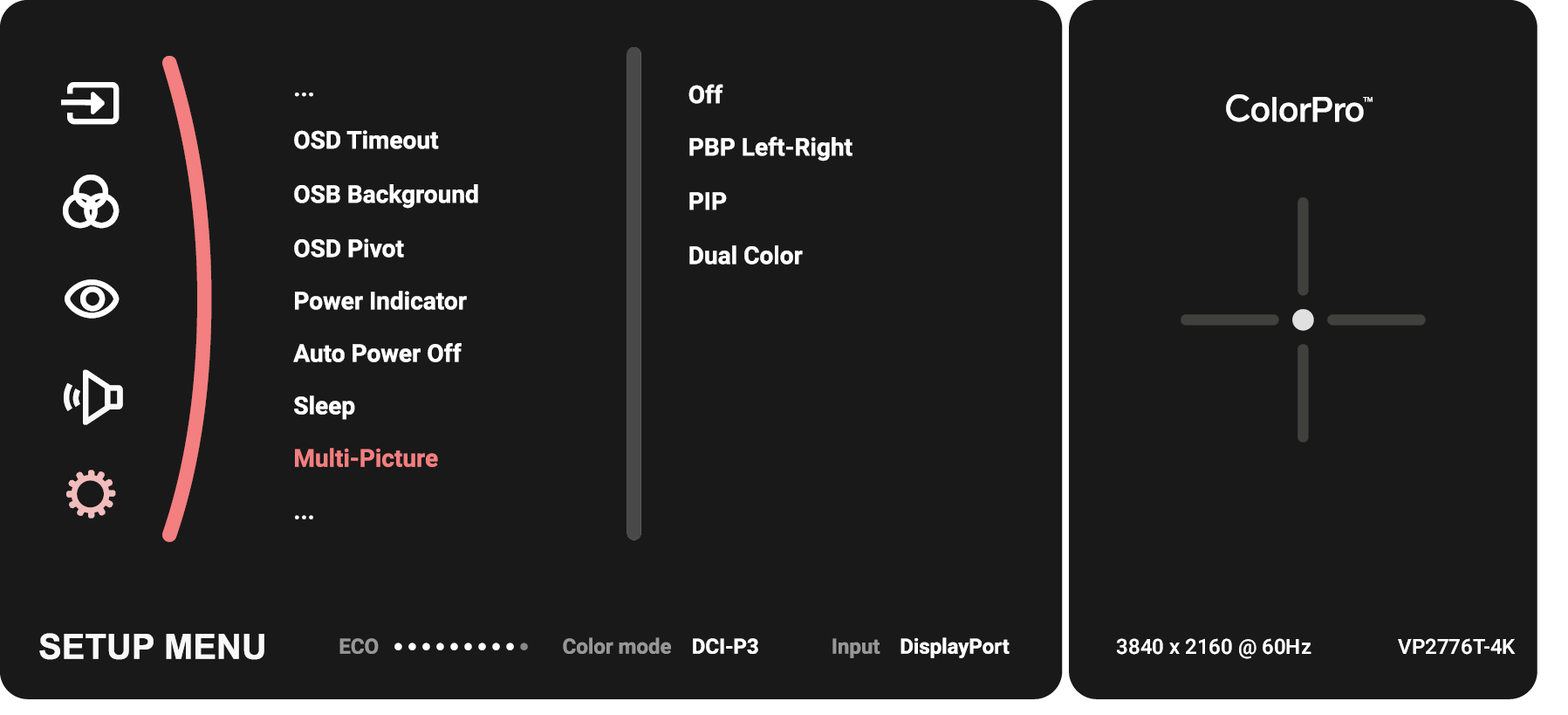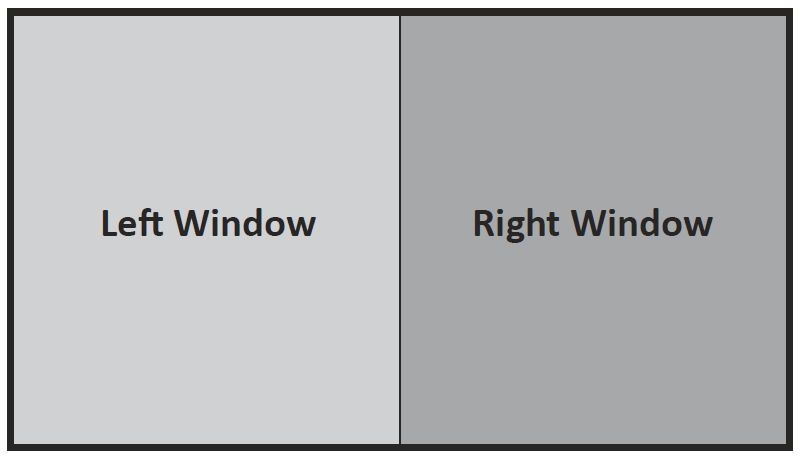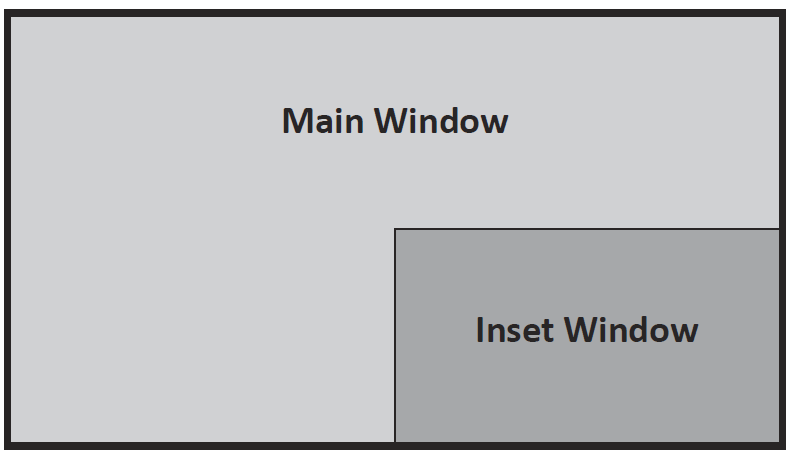VP2786a-4K Advanced Features and Settings
Auto Pivot
With the Auto Pivot function, the monitor can detect the image display and adjust the image’s orientation on the screen automatically when pivoting the screen vertically or horizontally.
- Note: The Auto Pivot function uses DDC/CI to communicate with the monitor. Before applying the Auto Pivot function, please make sure the DDC/CI setting is set to On.
To enable the DDC/CI setting:
- Open the OSD Menu and select the Setup Menu menu. Then press the Joy Key (
) to enter the menu.
- Move the Joy Key (
) or (
) to select DDC/CI. Then press the Joy Key (
) to enter its sub-menu.
Move the Joy Key (
) or (
) to select On. Then press the Joy Key (
) to confirm.
After making sure DDC/CI is On, proceed to set OSD Pivot to Auto:
- Open the OSD Menu and select the Setup Menu menu. Then press the Joy Key (
) to enter the menu.
- Move the Joy Key (
) or (
) to select OSD Pivot. Then press the Joy Key (
) to enter its sub-menu.
- Move the Joy Key (
) or (
) to select Auto. Then press the Joy Key (
) to confirm.
Backstage Lighting
With the Backstage Lighting function, the monitor can adjust the LED brightness to the optimal settings.
To configure the Backstage Lighting settings:
- Open the OSD Menu and select the Setup Menu menu. Then press the Joy Key (
) to enter the menu.
- Move the Joy Key (
) or (
) to select Backstage Lighting. Then press the Joy Key (
) to enter its sub-menu.
- Move the Joy Key (
) or (
) to select Level 1, Level 2, or Level 3 to enable the function. Then press the Joy Key (
) to confirm.
Colorbration+
To ensure long-term color accuracy, some specific models support the hardware color calibration function. The Colorbration+ application installation file can be found at our website.
Standard monitor packing does not include the color sensor, which the Colorbration+ application needs for the calibration process.
Compatible color sensors include:
- X-Rite i1 Display Pro
- X-Rite i1 Pro 2
- X-Rite i1 Studio
- Xrite Colormunki Photo
- Xrite Colormunki Design
- Datacolor SpyderX series
- ColorPro™ Wheel
Dual Color
The monitor comes with a dual color engine to display two different color settings in PIP (Picture-in-Picture) or PBP (Picture-by-Picture) mode. You can set different color presets in both windows (The Main Window and Secondary Window).
- Note: To enable PIP or PBP mode, refer to the Multi-Picture section.
To configure Dual Color:
- Move the Joy Key (
) to display the Startup Menu. Then navigate to Main Menu and press the Joy Key (
) to display the OSD Menu.
- Move the Joy Key (
) or (
) to select the Setup Menu menu. Then press the Joy Key (
) to enter the menu.
- Move the Joy Key (
) or (
) to select Multi-Picture. Then press the Joy Key (
) to enter its sub-menu.
- Move the Joy Key (
) or (
) to select Dual Color. Then press the Joy Key (
) to enter its sub-menu.
- Move the Joy Key (
) or (
) to select the desired color setting. Then press the Joy Key (
) to confirm.
Firmware Update
For the best display performance and to resolve any known issues, it is best to keep your monitor updated with the latest firmware version. With the supplied USB cable and the vDisplayManager application, you can easily update your monitor’s firmware.
To update the firmware:
- Download and install the vDisplayManager application from our website.
- Connect one end of a USB Type B cable to the USB Type B port of the monitor. Then connect the other end of the cable to a USB port of the computer.
- Launch vDisplayManager. Select the Advanced tab in the side menu.
- Click Update to check for any updates to your monitor’s firmware.
- Wait until the update process is complete (if applicable).
- Note: Any interruptions during the firmware update process may permanently damage your monitor. Do not disconnect the USB cable or turn off your PC and monitor.
HDR (High-Dynamic-Range)
HDR reduces the overall contrast of a given scene so that detail in the highlights and shadows can be better seen.
- Note: Please make sure the HDR setting is turned on on your device first before enabling HDR on the monitor.
To enable the HDR function:
- Move the Joy Key (
) to display the Startup Menu. Then navigate to Main Menu and press the Joy Key (
) to display the OSD Menu.
- Move the Joy Key (
) or (
) to select Color Mode. Then press the Joy Key (
) to enter the Color Mode menu.
- Move the Joy Key (
) or (
) to select HDR. Then press the Joy Key (
) to enter its sub-menu.
- Move the Joy Key (
) or (
) to select one of the options . Then press the Joy Key (
) to confirm.
KVM
The KVM function allows the user to control two computers connected to the same monitor from a single keyboard and mouse.
- Note: Only applicable in PBP (Picture-by-Picture) mode.
To connect the two computers to the monitor:
- Connect one end of a USB Type C cable to the USB Type C port of the monitor. Then connect the other end of the cable to the USB Type C port of the laptop.
- Connect one end of a DisplayPort cable to the DisplayPort port of the monitor. Then connect the other end of the cable to the DisplayPort or Mini DisplayPort of the computer.
- Connect one end of a USB Type B cable to the USB Type B port of the monitor. Then connect the other end of the cable to a USB port of the computer.
To enable PBP mode:
- Move the Joy Key (
) to display the Startup Menu. Then navigate to Main Menu and press the Joy Key (
) to display the OSD Menu.
- Move the Joy Key (
) or (
) to select the Setup Menu menu. Then press the Joy Key (
) to enter the menu.
- Move the Joy Key (
) or (
) to select Multi-Picture. Then press the Joy Key (
) to enter its sub-menu.
- Move the Joy Key (
) or (
) to select PBP Left-Right. Then press the Joy Key (
) to enable PBP mode.
To activate the KVM function:
- Move and hold the Joy Key (
) for two seconds to activate the KVM function.
- Then you will be able to switch the cursor between the two screens (left/right window).
Multi-Picture
Multi-Picture allows users to further customize their work space by allowing up to four split windows from different inputs, displaying high resolution content with different aspect ratios, without distortion from the original input sources.
To enable Multi-Picture mode:
- Move the Joy Key (
) to display the Startup Menu. Then navigate to Main Menu and press the Joy Key (
) to display the OSD Menu.
- Move the Joy Key (
) or (
) to select Color Mode. Then press the Joy Key (
) to enter the Color Mode menu.
- Move the Joy Key (
) or (
) to select Multi-Picture. Then press the Joy Key (
) to enter its sub-menu.
- Move the Joy Key (
) or (
) to select PBP Left-Right or PIP. Then press the Joy Key (
) to enter the selected mode.
PBP (Picture-by-Picture)
- Note: To display full-sized images in the windows, please adjust the screen resolution to 1920 x 1080 (PBP Left-Right).
To configure PBP:
- Move the Joy Key (
) to display the Startup Menu. Then navigate to Main Menu and press the Joy Key (
) to display the OSD Menu.
- Move the Joy Key (
) or (
) to select Setup Menu. Then press the Joy Key (
) to enter the Setup Menu menu.
- Move the Joy Key (
) or (
) to select Multi-Picture. Then press the Joy Key (
) to enter its sub-menu.
- Move the Joy Key (
) or (
) to select PBP Left-Right. Then press the Joy Key (
) to enter its sub-menu.
- To change the input source, select the source location (Left Source Select/Right Source Select) and press the Joy Key (
).
- Move the Joy Key (
) or (
) to select the desired input source and press the Joy Key (
) to confirm.
- To swap the two windows, select Swap and press the Joy Key (
) to confirm.
PIP (Picture-in-Picture)
To configure PIP:
- Move the Joy Key (
) to display the Startup Menu. Then navigate to Main Menu and press the Joy Key (
) to display the OSD Menu.
- Move the Joy Key (
) or (
) to select Setup Menu. Then press the Joy Key (
) to enter the Setup Menu menu.
- Move the Joy Key (
) or (
) to select Multi-Picture. Then press the Joy Key (
) to enter its sub-menu.
- Move the Joy Key (
) or (
) to select PIP. Then press the Joy Key (
) to enter its sub-menu.
- To change the input source for the Inset Window, select PIP Source Select and press the Joy Key (
). Then move the Joy Key (
) or (
) to select the desired input source and press the Joy Key (
) to confirm.
- To adjust the Inset Window position, select PIP Position and press the Joy Key (
).
- Press the Joy Key (
) to select PIP H.Position or PIP V.Position.
- Move the Joy Key (
) or (
) to adjust the setting and press the Joy Key (
) to confirm.
- To adjust the Inset Window size, select PIP Size and press the Joy Key (
). Then move the Joy Key (
) or (
) to adjust the setting.
- To swap the two windows, select Swap and press the Joy Key (
) to confirm.

